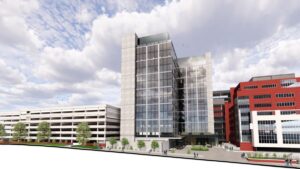Project Spotlight: Vanderbilt University Medical Center’s LINK Building

Image courtesy of VUMC.
Vanderbilt University Medical Center (VUMC), in Nashville, Tennessee, has hired SSR to provide engineering design and consulting services on the largest expansion project to date on their main campus adult hospital, Vanderbilt University Hospital (VUH). The new LINK building is a 15-story, 460,000 SF tower that will house patient beds, surgical support, imaging transplant and ortho clinics, offices, and administrative space. The need for expansion is driven by the unprecedented growth occurring in Middle Tennessee.
SSR has been engaged in this project since 2021, working with VUMC and Blair + Mui Dowd Architects to provide mechanical, electrical, plumbing, fire protection systems, and technology design for the core and shell of the building. Designing the building structure first allowed VUMC leadership more time to identify the desired programming for the building. What started off as an office tower that could be easily converted to critical care inpatient programming quickly evolved into an inpatient bed tower with institutional occupancy and only the top two floors as office space.
One of the initial challenges of the project is the tower’s small footprint. The new facility is being built over and between existing parking garages and up against the existing Medical Center East – South Tower. The footprint of the existing LINK garage is small and provides no “podium” type level that we typically see with large bed towers. Additionally, VUMC did not wish to connect the new LINK building to the existing mechanical, electrical, and plumbing (MEP) systems serving other buildings in the immediate vicinity. This decision necessitated a new stand-alone generator plant, chiller plant, boiler plant, and fuel oil farm systems to support the building and to be incorporated into the small footprint. The design team looked at other resources in the surrounding area to house these new systems and selected a solution where most of the electrical infrastructure for the LINK building will be housed outside of the new tower footprint.
Another challenge for the design team was the phased building design. While the design team had an idea of what the programming of each level would be, there was no final programming and architectural and structural development to design around or coordinate with as we would have in a typical building project. Close coordination with the owner and architectural teams to communicate programming decisions and design changes helped to address these issues.
Once complete (estimated for 2026), the LINK Building will provide VUMC with much needed beds and programming to meet the needs of the surrounding community.








